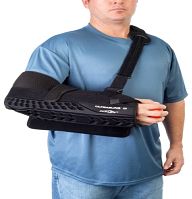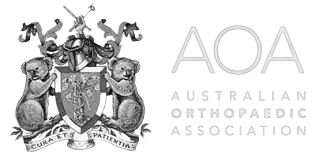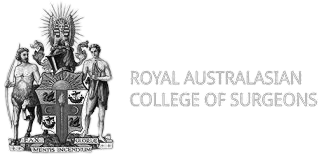Practice Locations
Bega Valley Centre for Bone & Joint Surgery Rajesh Orthopaedics
19 Canning St, Bega NSW 2550, Australia
Mogo Day Surgery
Mogo Day Surgery, 2-4 Charles St NSW 2536 Australia
Bombala St Surgery
62 Bombala St, Cooma NSW 2630, Australia
Rotator Cuff Repair
What is Rotator Cuff Repair?
The rotator cuff is a group of muscles and tendons that surround the shoulder joint and help stabilise and move the arm. When the rotator cuff tears, it can cause pain, weakness, and difficulty moving the arm.
Rotator cuff repair is a surgical procedure that involves repairing any tears in the rotator cuff muscles. The surgery is typically performed under general anaesthesia or a nerve block, and the surgeon will use either an arthroscope or an open incision to access the shoulder joint.
Who is Suitable for Rotator Cuff Repair?
Rotator cuff repair is usually recommended for patients with a rotator cuff tear that causes significant pain, weakness, and loss of motion. The ideal candidates for the procedure are those who have not responded well to non-surgical treatments such as physical therapy, rest, and medications.
The surgeon will assess the patient's overall health, medical history, and the extent of the rotator cuff tear to determine if the patient is suitable for the procedure. Factors such as age, activity level, and the tear's size and location will also be considered.
What are the Benefits of Rotator Cuff Repair?
Rotator cuff repair has several benefits, including:
- Pain relief: Rotator cuff tears can cause significant pain, and surgery can help relieve this pain.
- Improved function: The procedure can help restore the range of motion and strength in the shoulder joint, allowing patients to resume their daily activities and sports.
- Prevention of further damage: If left untreated, a rotator cuff tear can worsen and lead to other complications, such as arthritis or a frozen shoulder. Surgery can prevent further damage and improve long-term outcomes.
Types of Rotator Cuff Repair Surgery
There are numerous options for rotator cuff injuries, including
- Arthroscopic Tendon Repair: This type of surgery involves making several small incisions and using an arthroscope (a thin, flexible tube with a camera) to access the shoulder joint. The surgeon will then use small instruments to repair the torn muscle and tendon. This type of surgery is less invasive and has a shorter recovery time.
- Open Tendon Repair: This type of surgery involves making a larger incision to access the shoulder joint. It allows the surgeon to clearly see the torn muscle and tendon and repair it directly. This type of surgery is generally recommended for larger tears or more complex cases.
- Tendon Transfer: If the torn tendon is too damaged to be reattached to the arm bone, surgeons may replace it with a nearby tendon.
- Shoulder Replacement:
Large rotator cuff tears may necessitate shoulder replacement surgery. An innovative procedure (reverse shoulder arthroplasty) installs the ball part of the artificial joint onto the shoulder blade and the socket part onto the arm bone to improve the artificial joint's stability.

Small plastic anchors are screwed into the humeral rotator cuff insertion. The anchors contain strong braided sutures or tapes placed through the torn rotator cuff tendons.
The tendons are attached back to the humerus bone (arm) using knots or further anchors.
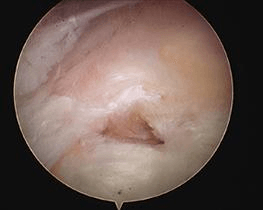
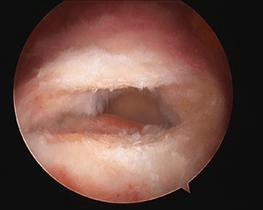
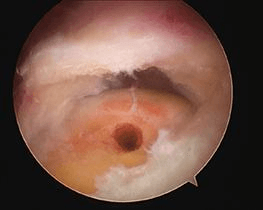
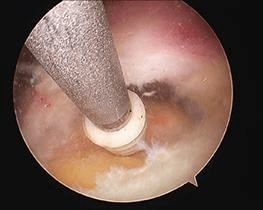
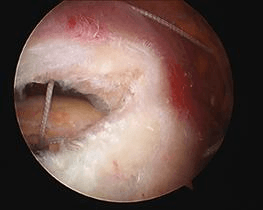

A degenerate, frayed, dislocating or inflamed long head of bicep tendonitis is usually removed from the joint. This may be achieved by releasing the biceps from the socket and letting it retract into the bicipital groove (tenotomy), shortening the tendon, and securing it into the proximal humerus (Tenodesis).
Tenodesis is favoured in the more active patients as it restores muscle strength.
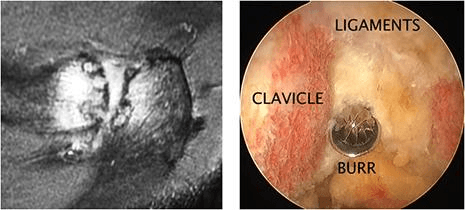

Alternative Options to Rotator Cuff Repair Surgery
While rotator cuff repair is a common treatment option for rotator cuff tears, alternative options can be considered, depending on the size and location of the tear, the patient's age, and overall health. These options include:
- Physical therapy: Physical therapy can help strengthen the muscles around the shoulder joint and improve the range of motion. This can be a good option for smaller tears or tears that do not cause significant pain or weakness.
- Corticosteroid injections: Corticosteroid injections can help relieve pain and reduce inflammation around the rotator cuff. This can be a good option for patients unsuitable for surgery or who prefer non-surgical treatments.
- Platelet-rich plasma (PRP) injections: PRP injections involve injecting the patient's platelets into the affected area to promote healing. This can be a good option for smaller tears or tears that do not respond well to physical therapy.
Preparation For Rotator Cuff Surgery
Before undergoing rotator cuff repair surgery, there are several things that patients can do to prepare themselves for the procedure.
- Patients should undergo a comprehensive medical evaluation to assess their overall health and identify any potential risk factors for the surgery.
- Patients are advised to quit smoking at least two weeks before the surgery. Smoking can delay healing and increase the risk of complications.
- Stop taking certain medications: Patients should stop taking certain medications that can increase the risk of bleeding, such as aspirin, at least two weeks before the surgery.
- Patients should prepare for post-operative care, including arranging for someone to drive them home after the surgery, arranging for assistance with daily activities, and stocking up on supplies.
Arthroscopic Rotator Cuff Repair Surgery
Arthroscopic rotator cuff repair is a minimally invasive surgical procedure commonly used to repair a torn rotator cuff. The procedure is performed under general anaesthesia and typically takes about two hours.
- Preparation: The patient is placed under general anaesthesia and positioned on their side with the affected arm facing up. The shoulder is then cleaned and sterilised with an antiseptic solution.
- Arthroscopy: The surgeon makes several small incisions in the shoulder, through which they insert an arthroscope (a thin, flexible tube with a camera) and other specialised instruments. The arthroscope lets the surgeon see inside the shoulder joint and identify the torn rotator cuff.
- Debridement: Before repairing the rotator cuff, the surgeon may need to remove any damaged tissue or bone spurs from the shoulder joint. This process is known as debridement.
- Tendon reattachment: The surgeon will use sutures and anchors to reattach the torn tendon to the bone. The sutures and anchors are made of strong, biocompatible materials to hold the repaired tendon in place while it heals.
- Closure: Once the rotator cuff has been repaired, the surgeon will close the incisions with stitches or adhesive strips and apply a bandage to the shoulder.
Post Surgery
The patient will wake up in the recovery room and then be transferred back to their hospital room.
- Pain medication will be provided to keep the patient comfortable.
- A bandage will be around the operated shoulder, and the arm will be in a sling or brace.
- The sling will be worn for about 4-6 weeks to facilitate healing.
The surgeon will see the patient before discharge and explain the operation's findings and what was done during surgery.
- The bandage will usually be removed 48 hours post-surgery, and place dressings provided by your surgeon over the area.
- It is normal for the shoulder to swell after the surgery. Placing ice packs on the shoulder will help to reduce swelling. Ice packs should be applied to the area for 20 min 3-4 times daily until swelling has reduced.
Rotator Cuff Repair Surgery Aftercare
After rotator cuff repair surgery, proper aftercare is essential to promote healing and ensure a successful recovery. Here are some tips on what to expect and how to care for yourself after rotator cuff repair surgery:
- Pain management: You will experience pain and discomfort after surgery. Your surgeon will prescribe pain medication to manage your pain. Make sure you take your medication as directed.
- Rest and immobilisation: You must rest your affected arm and keep it immobilised for several weeks to allow the repaired rotator cuff to heal. Your surgeon will provide a sling to support your arm and shoulder.
- Cold therapy: Applying ice to your shoulder for 20 minutes several times daily can help reduce pain and swelling.
- Physical therapy: You will need to undergo physical therapy to regain strength, range of motion, and flexibility in your shoulder. Your physical therapist will provide you with exercises to do at home to complement your in-office physical therapy.
- Follow-up appointments: You must attend follow-up appointments with your surgeon to monitor your progress and ensure that your shoulder is healing properly.
- Lifestyle modifications: Avoid activities that may put too much strain on your shoulder, such as heavy lifting or sports, for several months after surgery.
- Nutrition: A healthy, balanced diet can help speed up healing. Eat plenty of fruits, vegetables, and lean proteins.
- Patience: Recovery from rotator cuff repair surgery can be long. It may take several months to regain the full function of your shoulder. Be patient and follow your surgeon's instructions closely.
It is important to report any unusual symptoms or concerns to your surgeon, such as excessive pain, swelling, or fever. With proper aftercare, most patients can expect to fully recover and return to their normal activities without pain or limitations.
Rotator Cuff Surgery Risks and Complications
While rotator cuff surgery is a common and generally safe procedure, it does carry some risks and potential complications. Some of the most common risks and complications associated with rotator cuff surgery include:
- Infection: There is a risk of infection with any surgery. Your surgeon will take steps to minimise this risk, such as using antibiotics, but it is still possible for an infection to occur.
- Bleeding: There is a risk of bleeding during and after the surgery. Patients should avoid medications that can increase the risk of bleeding before surgery.
- Nerve damage: There is a risk of nerve damage during the surgery, which can cause numbness, weakness, or tingling in the arm.
- Stiffness: Some patients may experience stiffness in the shoulder joint after the surgery, limiting the range of motion.
- Failure to heal: In some cases, the rotator cuff repair may fail properly, requiring additional surgery.
- Adhesive capsulitis (frozen shoulder): This is a condition in which the shoulder joint becomes stiff and painful, limiting the range of motion. It can occur as a result of rotator cuff surgery.
- Blood clots: There is a small risk of developing blood clots in the legs or lungs after surgery.
- Anaesthesia complications: General anaesthesia carries risks, including respiratory problems, reactions to the medication, and heart problems.
Rotator Cuff Repair Prognosis
Generally, patients can expect to experience significant pain and discomfort in the days and weeks following the surgery. However, most patients can expect to recover and regain full shoulder joint function with proper care and attention. The success rate of rotator cuff repair surgery is generally high, with over 90% of patients experiencing significant improvement in pain and function.
What if Rotator Cuff Repair is Delayed?
If rotator cuff repair surgery is delayed, the tear may worsen and become more difficult to repair. In some cases, delaying the surgery can lead to other complications, such as arthritis or a frozen shoulder.
Patients considering rotator cuff repair surgery should discuss their options with their surgeon and consider the potential risks and benefits of delaying the surgery.
Sometimes, non-surgical treatments such as physical therapy or corticosteroid injections may be recommended to manage pain and improve function. However, surgery may be the best option for a successful outcome for larger tears or tears that cause significant pain and weakness.
All Rights Reserved | Dr Krishnankutty Rajesh | Privacy
